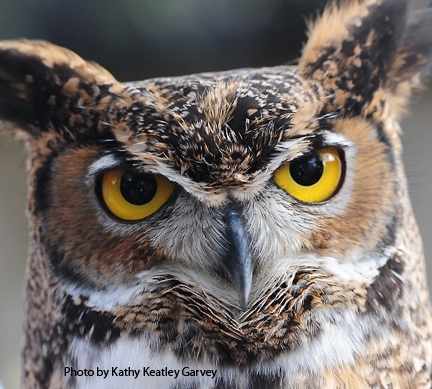
"Owl that" at more at the ninth annual UC Davis Biodiversity Museum Day on Saturday, Feb. 15 when 13 museums and collections showcase their projects.
The event, to take place from 9 a.m. to 4 p.m., is free and family friendly. All 13 sites are within walking distance except for the Häagen-Dazs Honey Bee Haven on Bee Biology Road and the Raptor Center on Old Davis Road.
The science-based event, always held the Saturday of Presidents' Day weekend, features the diversity of life. It is billed as a “free, educational event for the community where visitors get to meet and talk with UC Davis scientists from undergraduate students to staff to emeritus professors and see amazing objects and organisms from the world around us,” according to Biodiversity Museum Day coordinator Tabatha Yang, education and outreach coordinator for the Bohart Museum of Entomology. The schedule is online.
Last year's event drew more than 4000 visitors. Schedules vary from collection to collection.
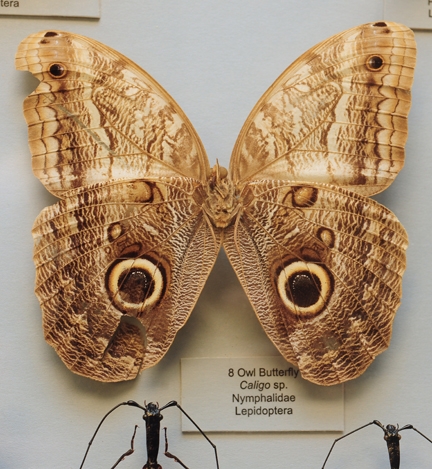
- The Botanical Conservatory, the Greenhouses along Kleiber Hall Drive, will be open from 9 a.m. to 4 p.m.
The following five will be open from 9 a.m. to 1 p.m.:
- Arboretum and Public Garden, Shields Oak Grove, alongside the Vet School, Garrod Drive on campus
- Bohart Museum of Entomology, Room 1124 and Main Hall of the Academic Surge Building, Crocker Lane
- California Raptor Center, 340 Equine Lane, off Old Davis Road
- Museum of Wildlife and Fish Biology, Room 1394 and Mail Hall, Academic Surge Building, Crocker Lane
- Paleontology Collection, Earth and Physical Sciences Building, 434 LaRue Road
Two collections will be open from 10 a.m. to 2 p.m.:
- Phaff Yeast Culture Collection, Robert Mondavi Institute of Wine and Food Science, 392 Old Davis Road, on campus
- Viticulture and Enology Culture Collection, Robert Mondavi Institute of Wine and Food Science, 392 Old Davis Road, on campus
These four will be open from noon to 4 p.m.:
- Anthropology Museum, 328 Young Hall and grounds
- Center for Plant Diversity, Sciences Laboratory Building, off Kleiber Hall Drive
- Häagen-Dazs Honey Bee Haven, Bee Biology Road, off Hopkins Road (take West Hutchison Drive to Hopkins)
- Nematode Collection, Sciences Laboratory Building, off Kleiber Hall Drive
- Marine Invertebrate Collection, Sciences Laboratory Building, off Kleiber Hall Drive
New this year will be public talks from noon to 1 p.m. in 194 Young Hall. Speaking will be butterfly expert Art Shapiro, distinguished professor of evolution and ecology; Gabriella Nevitt, professor, Department of Neurobiology, Physiology and Behavior, College of Biological Sciences; and Melanie Truan, staff research associate, Museum of Wildlife and Fish Biology and former postdoctoral researcher at UC Davis. Titles will be announced.
All participating museums and collections have active education and outreach programs, Yang said, but the collections are not always accessible to the public. Maps, signs and guides will be available at all the collections, and also online at http://biodiversitymuseumday.edu, and on social media, including Facebook and Twitter, @BioDivDay.
Capsule information on each:
Arboretum and Public Garden, 9 a.m. to 1 p.m.
Melissa Cruz Hernandez, outreach and leadership program manager, Arboretum and Public Garden, notes that the Arboretum activities will all be at the Shields Oak Grove, alongside the School of Veterinary Medicine, Garrod Drive. This is a change from last year. The Arboretum Ambassadors are planning fun-filled oak tree conservation activities the whole family will enjoy. “Learn about the many contributions oaks make to sustaining habitat biodiversity, what UC Davis and the Arboretum and Public Garden are doing to protect the trees, and win prizes for participating in the games at the Shields Oak Grove!”
Hernandez announced the following Arboretum activities:
- GATEways Outreach Ecological group: Learn what it is like to live as an oak tree through a life size board game and win prizes! Explore the ecological impacts oaks have in our community and discover about how the changing climate is impacting this important species.
- GATEways Outreach Humanities group: Did you know the US Constitution was signed in oak gall ink? Join us and try out oak gall ink for yourself, and engage in mindfulness activities.
- Museum Education: Take a self-guide tour through our iconic oak grove and learn about the unique characteristics of 12 of our favorite trees.
- Emily Griswold Tour: Join oak expert and Director of GATEways Horticulture, Emily Griswold, on an engaging tour of the oak grove. Uncover behind the scenes information about the grove and get your quercus questions answered.
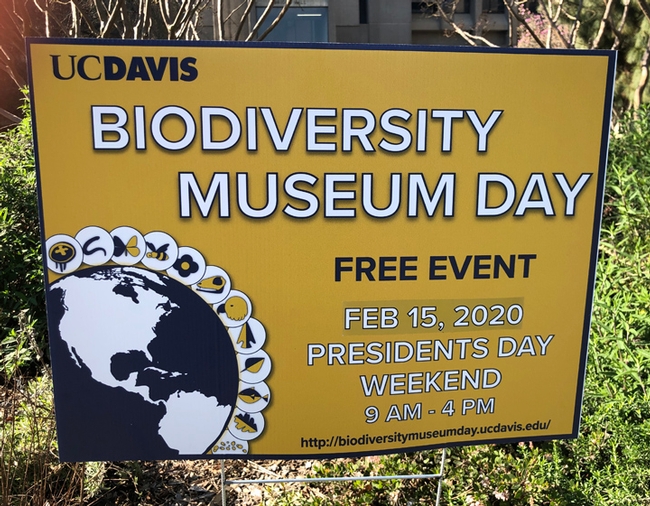
The Bohart Museum of Entomology, located in Room 1124 of the Academic Surge Building on Crocker Lane, is the home of a global collection of nearly 8 million insect specimens. Insect scientists will meet with the public to help them explore insects and spiders (arachnids). Highlights will include the 500,000-specimen butterfly/moth collection, curated by entomologist Jeff Smith. The Bohart maintains a live “petting zoo,” comprised of Madagascar hissing cockroaches, walking sticks and tarantulas. Also, the UC Davis Library set up a Mary Foley Benson exhibit in the Academic Surge hallway. It will be up ponly for the month of February. "The library, is, of course full of special collections including very important research materials on bees and on nematodes," noted Tabatha Yang, the Bohart education and outreach coordinator.
California Raptor Center, 9 a.m. to 1 p.m.
Visitors to the The California Raptor Center, located at 1340 Equine Lane, Davis, just off Old Davis Road, will see a living collection of non-releasable raptors. The center's educational ambassador birds will be out "on the glove," so visitors can get a close view of the birds of prey, and talk to the volunteers. Julie Cotton, volunteer and outreach coordinator, said visitors will see "on the glove" Swainson's hawks, a white-tailed kite, barn owl, great-horned owls and a eregrine falcon. Viewable in their exhibits will be golden eagles, American kestrels, turkey vultures, prairie falcon and Western screech owls.
Museum of Wildlife and Fish Biology, 9 a.m. to 1 p.m
The Museum of Wildlife and Fish Biology, located in Room 1394 of the Academic Surge Building, Crocker Lane (off LaRue Road) will feature an action packed morning with displays highlighting carnivores, bats, reptiles and fish, said director Andrew Engilis Jr. Visitors will see specimen preparation demonstrations. Also planned is a kids' craft table.
Paleontology Collection, 9 a.m. to 1 p.m.
Visitors at the Paleontology Collection, located in the Earth and Physical Sciences Building, 434 LaRue Road, can view fossil specimens dating from as old as 550 million years ago to more recent animal skeletons. Paleontology graduate students in invertebrate and vertebrate paleontology will answer questions and provide interesting factoids.
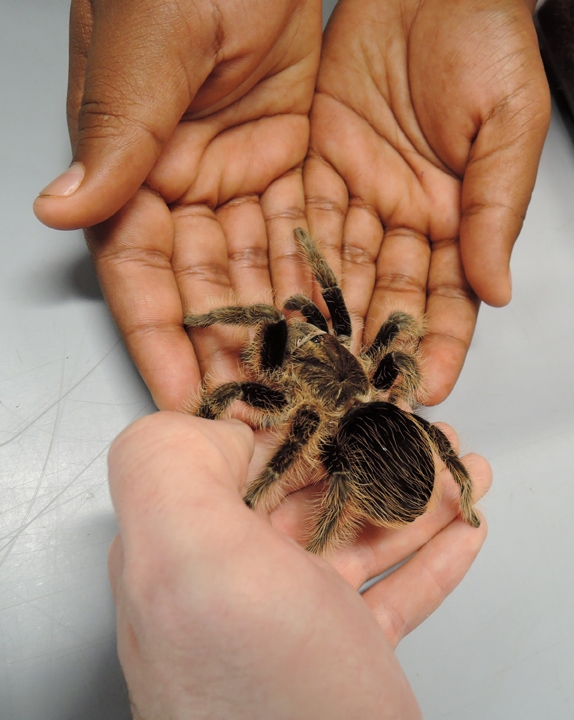
The Phaff Yeast Culture Collection in the Department of Food Science, and the Wine Yeast and Bacteria collection in the Department of Viticulture and Enology, are jointly hosting exhibits and tours. They are located at the Robert Mondavi Institute Teaching Winery and Brewery Building, 392 Old Davis Road, on campus. Visitors to the yeast collection exhibits can taste kombucha and Vegemite, smell lots of different species of yeast, look at yeast and bacteria cells under the microscope, learn about the history of yeast research at UC Davis, and hear about the latest discoveries coming out of the UC Davis yeast collections, says Kyria Boundy-Mills, curator of the Phaff Yeast Culture Collection, Food Science and Technology.
Anthropology Museum, noon to 4 p.m.
Visitors to the Department of Anthropology Museum, located in 328 Young Hall, will see collections of archaeological, ethnographic, biological and archival materials. They will "experience our cultural diversity through art pieces from around the world, our complex evolutionary history through primate skeletons and fossil hominin casts, or how archaeologists at UC Davis work across the globe to understand past cultural diversity through the artifacts people leave behind," said Professor Christyann Darwent of the Department of Anthropology. "There will also be an opportunity for visitors to learn to make tools from obsidian stone and to throw a spear with an atlatl."
The Botanical Conservatory, 9 a.m. to 4 p.m.
"We again expect our cacao tree to be loaded with ripe fruit for display amongst the plethora of plant we'll be displaying!" says collections manager Ernesto Sandoval. "We'll also be showcasing our very well established pond that made a splash last year and newly added small epiphyte tree along with three towering Titan Arums in leaf! if the outdoor weather is good, Visitors will be encouraged to take a walk over to the nearby Joe and Emma Lin Biological Orchard and Gardens and bask in the biodiversity of these sizable plots of Biodiversity and the neatly pruned fruit tree orchard." The Botanical Conservatory is located on Kleiber Hall Drive.
Center for Plant Diversity Herbarium, noon to 4 p.m.
Visitors to the Center for Plant Diversity Herbarium, located in Room 1026 of the Sciences Laboratory Building, central campus (off Kleiber Hall Drive), can tour the collection area, see plant pressing and mounting demonstrations, “pet our plant zoo” (a table showcasing the diversity of plants, including mosses, pine cones, ferns and flowering plants); look and plants under a microscope, and view oak exhibit. The children's activity? Making herbarium specimens, says curator Ellen Dean.
Häagen-Dazs Honey Bee Haven, noon to 4 p.m.
Visitors to the Häagen-Dazs Honey Bee Haven, a half-acre bee demonstration garden located next to the Harry H. Laidlaw Jr. Honey Bee Research Facility, Bee Biology Road, can learn about bees and see the plants they frequent, said manager Christine Casey. Guests will learn how to identify bees. They can also use a bee vacuum to catch, observe and release bees. A six-foot long sculpture of a worker bee by artist Donna Billick of Davis anchors the haven.
Nematode Collection, noon to 4 p.m.
The nematode collection will open from noon to 4 p.m. in the Science Laboratory Building, off Kleiber Hall Drive. It will feature both live and slide-mounted nematodes, as well as jars of larger parasites. Nematodes, also called worms, are described as “elongated cylindrical worms parasitic in animals or plants or free-living in soil or water. They exist in almost every known environment.”
Marine Invertebrate Collection, noon to 4 p.m.
The Marine Invertebrate Collection in the Science Laboratory Building, off Kleiber Hall Drive, will have touch tanks, preserved specimens, and some displays showing aspects of marine ecology and evolution. There will also be a seashell activity for kids, said Ivana Li. "In our touch tanks, we'll likely have sea stars and sea urchins. We are showing all the different geographical locations from which they were collected. This means that people can match up where specimens like our slipper lobster or salp came from. Other displays that we will have are on how to distinguish true crabs from other animals, and a display on seaweed ecology."
The sponsors made it all possible to have this event free to the public, Yang said. Ink Monkey is providing 300 t-shirts for the volunteers, and Marrone Bio Innovations and Novozymes are also major supporters. Other supporters include the UC Davis Honey and Pollination Center, UC Davis Library, White Labs Inc., Margaret Berendsen, Fletchers Real Estate, Peter Lash and Dan Potter.
Further information is available on the UC Davis Biodiversity Museum Day website.
Attached Images:
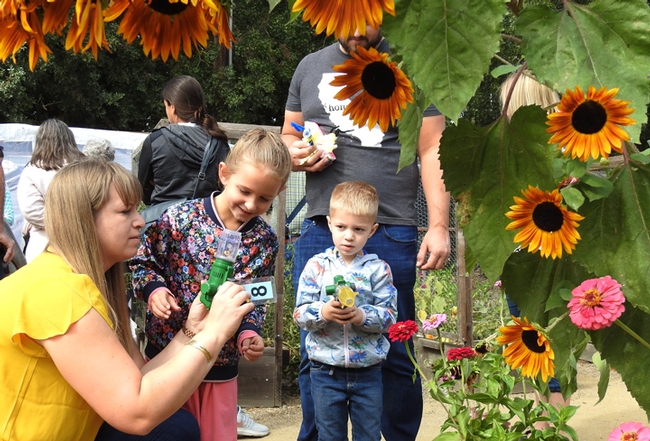
Missy Gable, director of the UC Master Gardener Program, shows her children Emma and Bran how to use a bee vacuum device at the Häagen-Dazs Honey Bee Haven. Missy, then Missy Borel, served as the founding manager of the haven. (Photo by Kathy Keatley Garvey)
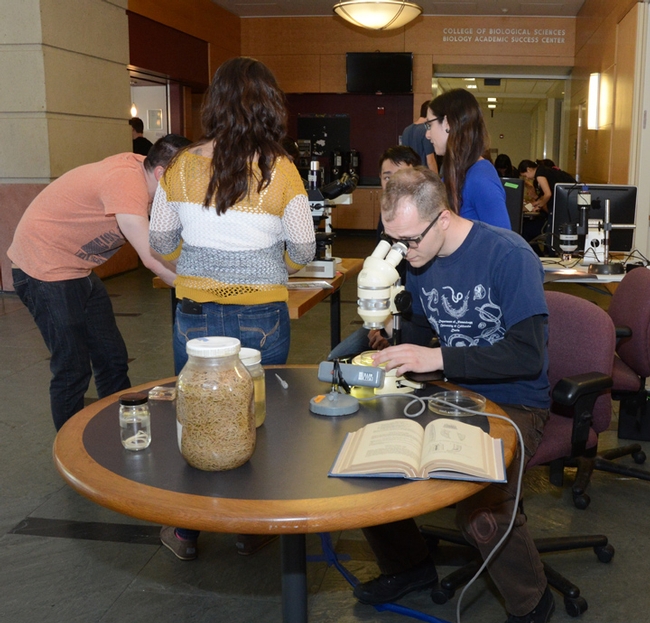
Nematologist and doctoral student Corwin Parker examines a nematode specimen. (Photo by Kathy Keatley Garvey)
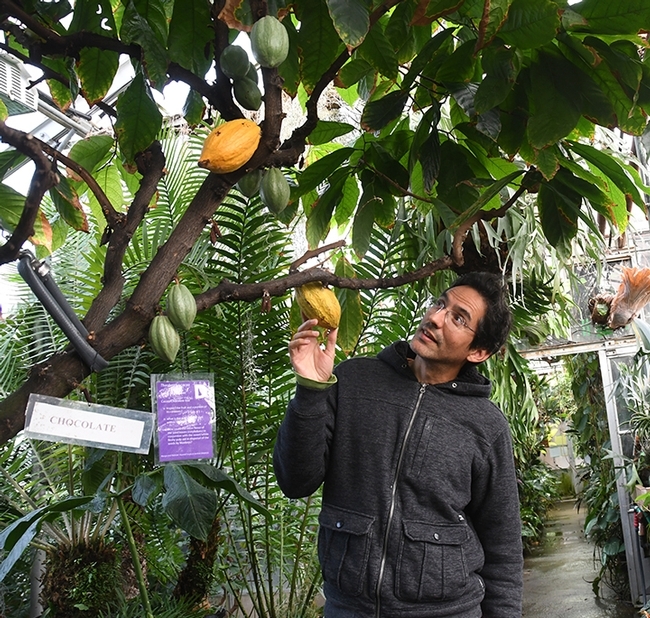
A chocolate tree? You bet! Ernesto Sandoval, collections manager at the Botanical Conservatory, checks out a cacao tree. (Photo by Kathy Keatley Garvey)